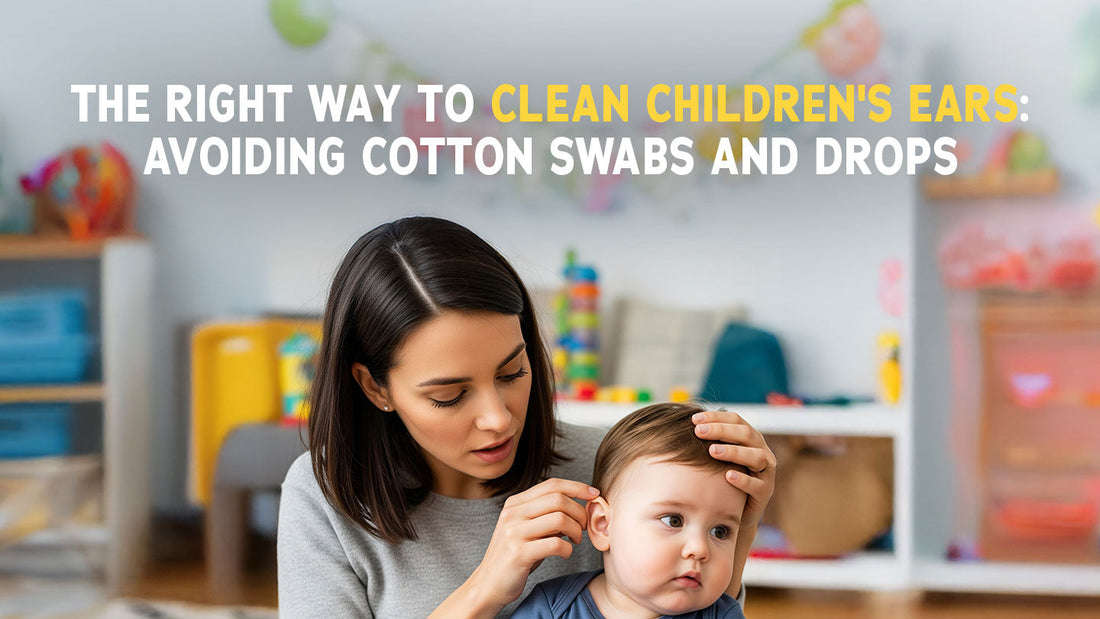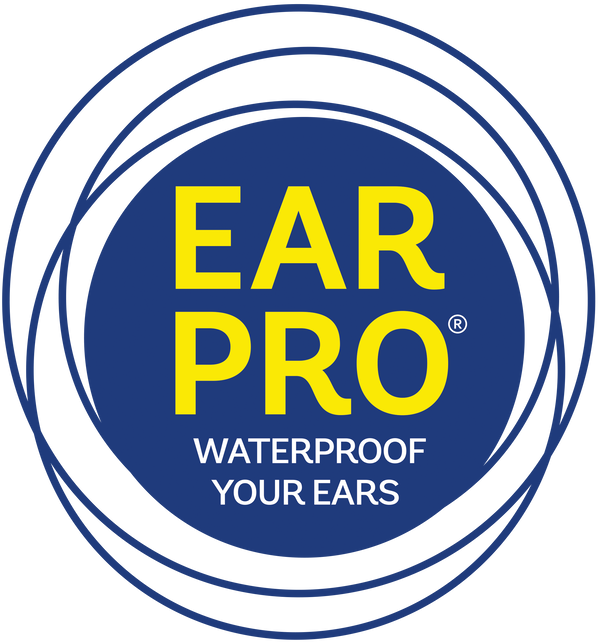
The Right Way to Clean Children's Ears: Avoiding Cotton Swabs and Drops
Share
Keeping a child’s ears healthy starts with safe ear cleaning for children, a practice that protects delicate ear canals, preserves natural hearing, and spares parents frantic clinic visits.
The safest way to clean a child’s ears is to wipe the outer ear with a warm cloth and, when needed, use a pediatric-friendly mineral-oil spray instead of cotton swabs or harsh drops.
Below is a science-backed guide that shows exactly how to keep little ears clear without cotton swabs or harsh drops.
Table of Contents
1. Understanding Children's Ear Anatomy And Self-Cleaning
2. Why Cotton Swabs Are A Big No-No For Little Ears
3. The Risks Of Ear Drops For Routine Cleaning In Kids
4. Recognizing Normal Earwax In Children
5. The Right Way To Clean The Outer Ear
6. When To Consider Gentle Earwax Softening Solutions
7. Tips For Preventing Excessive Earwax Buildup
8. Addressing Common Parental Concerns About Kids' Ears
9. When To Seek Professional Medical Advice For Your Child's Ears
10. Conclusion
11. Frequently Asked Questions
Understanding Children's Ear Anatomy And Self-Cleaning
A child’s ear removes wax on its own, yet many parents still reach for swabs.
How Ear Canals Naturally Remove Wax
A child’s ear canal is lined with migrating skin that ushers wax outward like a conveyor belt.
According to this study, interfering with this cycle can shove debris deeper and cause painful infections.

Why Babies Produce Softer Cerumen
Infants secrete moist wax that traps dust and bacteria before sliding out. Over-cleaning dries this protective layer and raises infection odds.
Do Kids Need Ear Cleaning Every Day?
Pediatric audiologists agree that routine wiping of the outside is enough; inside cleaning is rarely required unless a doctor advises it.
Why Cotton Swabs Are A Big No-No For Little Ears
Even a tiny swab can damage the canal wall and eardrum.
Risk Of Push-Ins And Injury
Swabs often push wax closer to the eardrum rather than pulling it out, negating safe ear cleaning for children and risking perforation.
Can Cotton Swabs Cause Hearing Loss?
Yes. Impacted wax can dampen sound conduction. Worse, an accidental jab can rupture the tympanic membrane and require surgery.
Safer Tools Than Swabs
Use a soft washcloth and alternatives to cotton swabs for kids, such as mineral-oil sprays that lubricate and let wax glide out naturally.
The Risks Of Ear Drops For Routine Cleaning In Kids
Pharmacy drops may contain alcohol or hydrogen peroxide that can be irritating for tender canals.
Chemical Irritation And Allergies
Harsh formulations strip protective oils and can inflame tissue, undermining gentle child ear hygiene.
Are Drugstore Drops Safe For Daily Use?
No. Experts warn against habitual application; reserve medicated drops for doctor-diagnosed infections.
When Doctors Prescribe Drops
Ear drops for cerumen removal are generally safe and appropriate for managing pediatric earwax impaction, regardless of infection status.
However, if an ear infection is present, A healthcare provider may prescribe specific medicated drops with precise dosing.
Recognizing Normal Earwax In Children
Wax color and amount vary, yet most presentations are healthy.
Color And Texture Guide For Parents
Yellow to light brown wax that is soft or flaky is normal and part of preventing earwax buildup in children.
What Does Too Much Earwax Look Like?
If wax blocks the canal’s view or causes discomfort, schedule an exam.
Signs It’s Time To See A Professional
Persistent pain, foul odor, or hearing loss demands prompt medical review.
The Right Way To Clean The Outer Ear
Surface cleaning keeps ears fresh without invading the canal.
Warm Cloth Wipe Method
Gently wipe the outer ear with a warm, damp cloth after baths, which is an example of healthy ear care practices for toddlers.
Can I Use Mineral Oil On The Auricle?
Yes. A few drops soften crusted wax and moisturize skin without trauma, supporting safe ear cleaning for children.
Introducing Ear Pro's Protective Barrier
One mist of Ear Pro forms a breathable mineral-oil film that repels water and debris. Explore details on the Ear Pro home page.
When To Consider Gentle Earwax Softening Solutions
Mineral oil is pediatric-friendly and evidence-backed.
Mineral Oil As A Pediatric-Friendly Aid
Audiologists list it as the top audiologist-recommended child ear cleaning method when natural migration stalls.

How Often Should Oil Be Applied?
Once or twice each week suffices. Overuse can oversaturate canals.
Ear Pro vs Harsh Peroxide
Ear Pro is alcohol-free and non-stinging, which is why it is perfect for non-invasive ear care for young children needing a boost without chemicals.
Before trying any DIY hacks, skim the how to use Ear Pro walkthrough, which demonstrates how one quick mist coats the canal, loosens stubborn wax, and shields delicate skin from moisture.
Tips For Preventing Excessive Earwax Buildup
Simple habits can keep ears happy long term.
Balanced Bath Time Routines
Avoid soapy water seeping into canals; suds dissolve wax and hinder keeping kids' ears clear safely.

Does Diet Affect Wax Formation?
Hydration and balanced fats help maintain pliable wax that exits naturally.
Using Ear Pro Before Water Play
Spraying before swimming cushions canals against moisture, enhancing safe ear cleaning for children, and stopping swimmer’s ear.
To understand how harsh water can dry the canal lining and make wax stickier, parents whose children frequent chlorinated pools should review the effects of pool chemicals on kids’ ear irritation.
Addressing Common Parental Concerns About Kids' Ears
Parents often worry about fullness or muffled hearing.
Why My Child Says Ears Feel Full
Temporary blockage could be wax or fluid. Observe 24 hours before intervening.
Can Ear Pro Replace Earplugs?
Yes. Its water-repelling shield rivals plugs yet remains comfortable.
If your child often has lingering water in their ears after swim lessons, our guide provides quick, pediatric-approved tricks to prevent water from getting stuck in the ear.
Debunking Ear Candling Myths
Candles create suction burns and exemplify the dangers of putting things in a child's ear. Skip them.
When To Seek Professional Medical Advice For Your Child's Ears
Timely care prevents complications.
Red Flags That Need An Audiologist
Fever, drainage, or sudden hearing loss require clinic visits for safe ear cleaning for children's protocols.
How Often Should Kids Have Ear Checks?
Annual pediatric check-ups suffice unless symptoms appear.
Truly Non-Invasive procedures
Doctors use irrigation or micro-suction, both qualify as a parent's guide to kids' ear health gold standards.
Conclusion
Cerumen protects, swabs harm, and alcohol-based drops dry delicate skin.
Follow the steps above for safe ear cleaning for children, lean on mineral-oil protectors, and call a professional when in doubt. Ready to safeguard little ears before the next swim?
Grab a bottle of mineral oil Ear Pro here and let protective care mist the worries away.
If your child is starting swim classes, the swim school guide shows how instructors can help to aid ear protection in water.
Frequently Asked Questions
1. What is the safest way to clean a child's ears?
The safest method is safe ear cleaning for kids.
Gently wipe the outer ear with a warm, damp cloth, and when extra help is needed, use a pediatric-friendly mineral-oil spray such as Ear Pro rather than inserting objects into the canal.
2. Should I clean my child's ears with cotton swabs?
No. Cotton swabs often push wax deeper, scratch delicate skin, and may puncture the eardrum. Stick to surface wiping or other doctor-approved, non-invasive options.
3. Are ear drops safe for children's earwax?
Use them only when a healthcare professional prescribes them.
Frequent use of over-the-counter drops, especially those containing alcohol or peroxide, can irritate young ear canals.
Mineral-oil sprays provide a gentler alternative for routine care.
4. How can I get wax out of my child's ears without cotton swabs?
Allow the ear’s natural process to clear most wax.
If buildup persists, apply a few warm mineral-oil drops or give a quick mist of Ear Pro, tilt the head to let softened wax drain, and consult a pediatrician if blockage remains.

